Legal Analysis: Contractual Terms, Negligence, and Case Studies
VerifiedAdded on 2019/12/03
|13
|3998
|192
Report
AI Summary
This report delves into the intricacies of contract law, examining its essential elements such as offer, acceptance, consideration, and intention. It explores various types of contracts, including face-to-face, distance, written, and verbal agreements, and their applicability in given case scenarios. The report analyzes the application of these elements in specific case studies, focusing on the implications of contractual terms, including expressed terms like conditions, warranties, and exclusion clauses, and implied terms. It contrasts contractual and tort liability, highlighting the nature of negligence and vicarious liability in business contexts. The report also discusses defenses provided by negligence law, supported by case studies, offering a comprehensive understanding of contract and tort law principles.
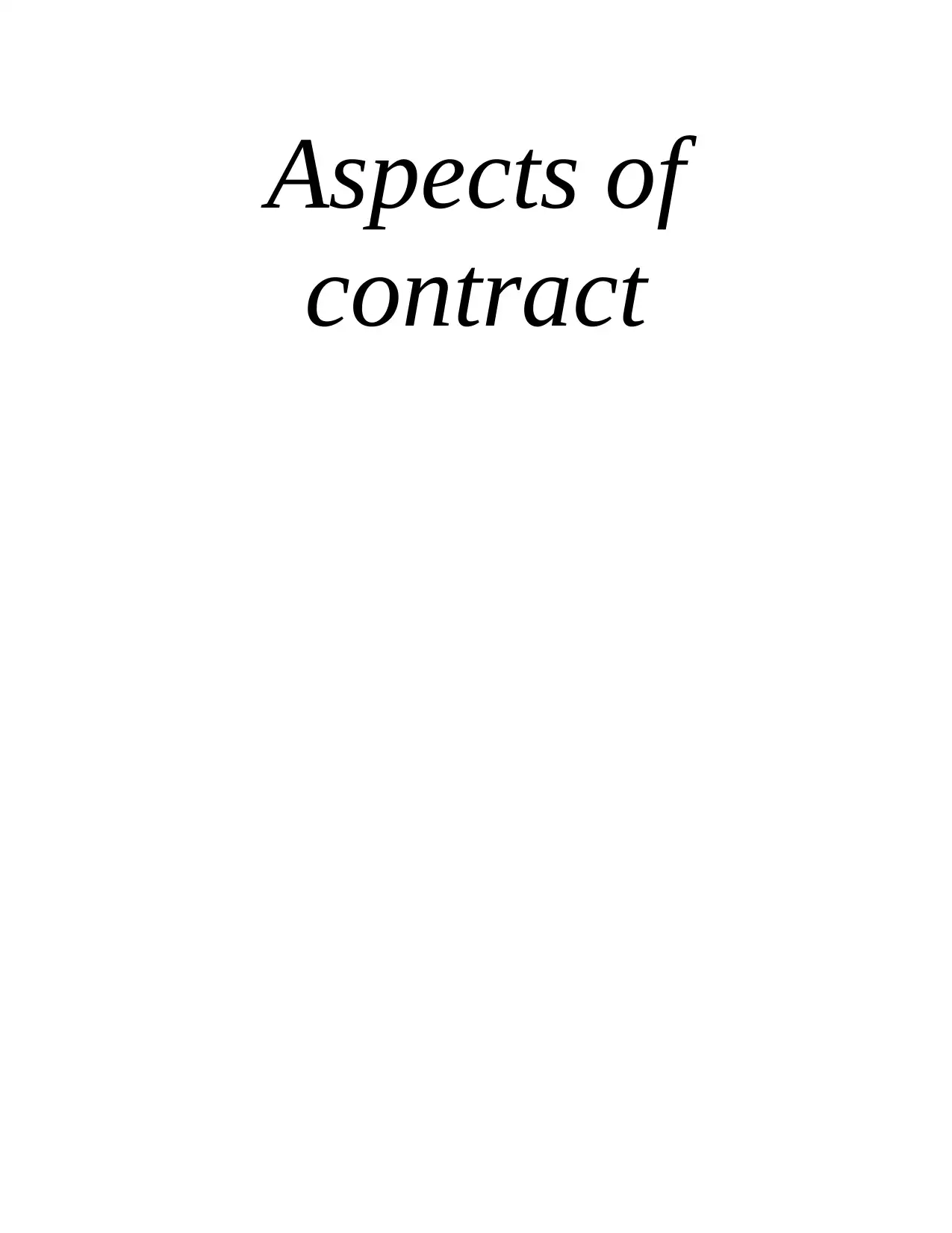
Aspects of
contract
contract
Paraphrase This Document
Need a fresh take? Get an instant paraphrase of this document with our AI Paraphraser
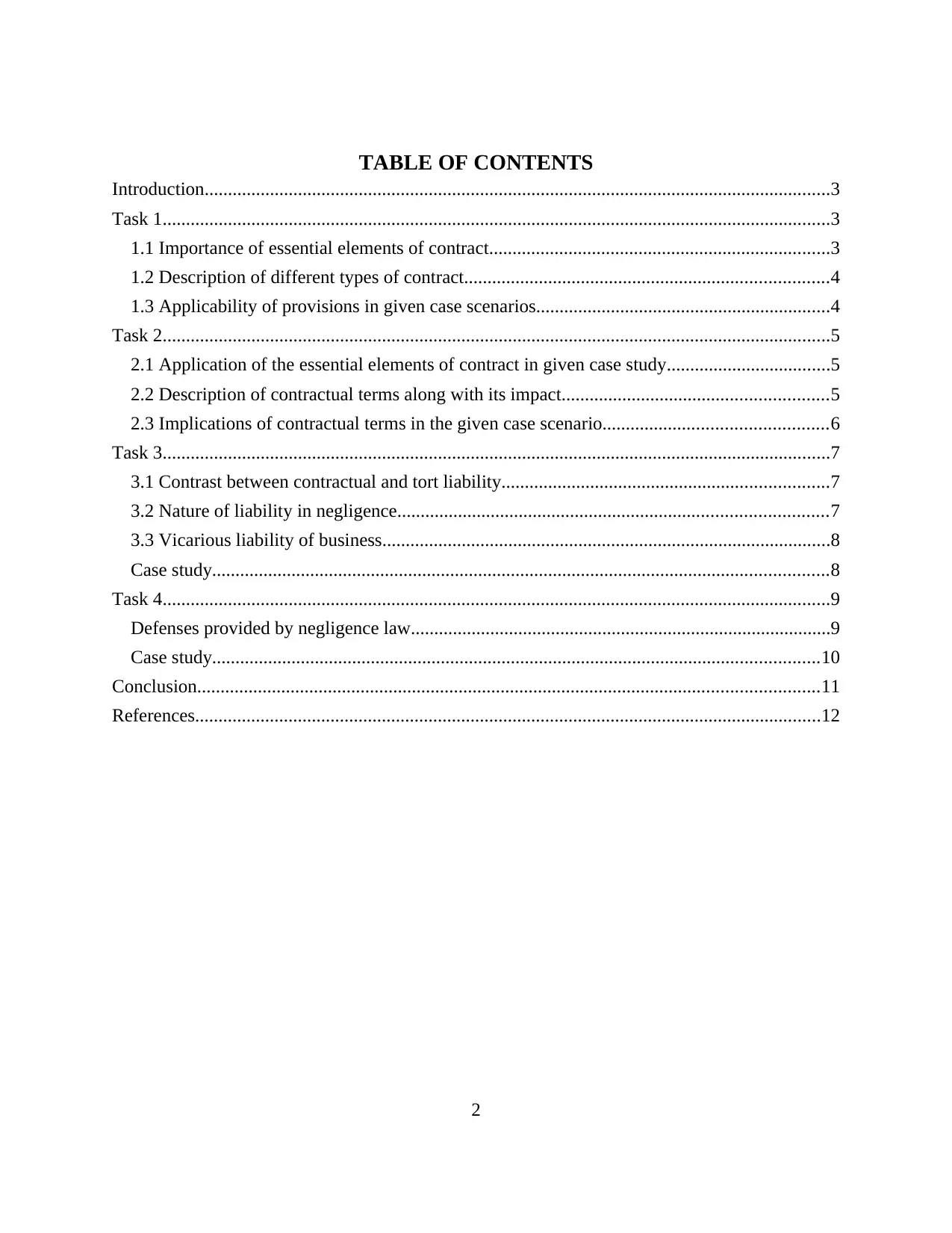
TABLE OF CONTENTS
Introduction......................................................................................................................................3
Task 1...............................................................................................................................................3
1.1 Importance of essential elements of contract.........................................................................3
1.2 Description of different types of contract..............................................................................4
1.3 Applicability of provisions in given case scenarios...............................................................4
Task 2...............................................................................................................................................5
2.1 Application of the essential elements of contract in given case study...................................5
2.2 Description of contractual terms along with its impact.........................................................5
2.3 Implications of contractual terms in the given case scenario................................................6
Task 3...............................................................................................................................................7
3.1 Contrast between contractual and tort liability......................................................................7
3.2 Nature of liability in negligence............................................................................................7
3.3 Vicarious liability of business................................................................................................8
Case study....................................................................................................................................8
Task 4...............................................................................................................................................9
Defenses provided by negligence law..........................................................................................9
Case study..................................................................................................................................10
Conclusion.....................................................................................................................................11
References......................................................................................................................................12
2
Introduction......................................................................................................................................3
Task 1...............................................................................................................................................3
1.1 Importance of essential elements of contract.........................................................................3
1.2 Description of different types of contract..............................................................................4
1.3 Applicability of provisions in given case scenarios...............................................................4
Task 2...............................................................................................................................................5
2.1 Application of the essential elements of contract in given case study...................................5
2.2 Description of contractual terms along with its impact.........................................................5
2.3 Implications of contractual terms in the given case scenario................................................6
Task 3...............................................................................................................................................7
3.1 Contrast between contractual and tort liability......................................................................7
3.2 Nature of liability in negligence............................................................................................7
3.3 Vicarious liability of business................................................................................................8
Case study....................................................................................................................................8
Task 4...............................................................................................................................................9
Defenses provided by negligence law..........................................................................................9
Case study..................................................................................................................................10
Conclusion.....................................................................................................................................11
References......................................................................................................................................12
2
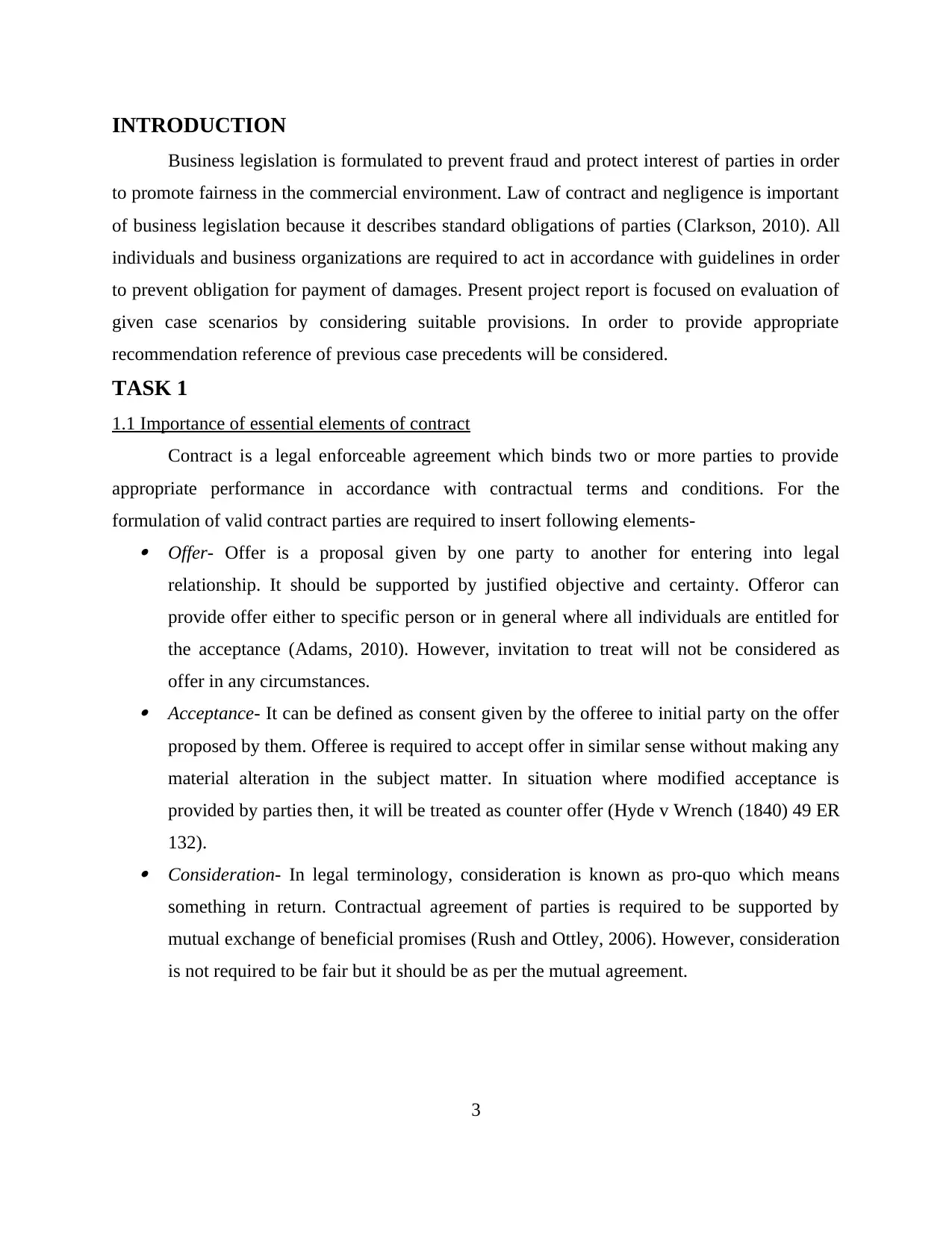
INTRODUCTION
Business legislation is formulated to prevent fraud and protect interest of parties in order
to promote fairness in the commercial environment. Law of contract and negligence is important
of business legislation because it describes standard obligations of parties (Clarkson, 2010). All
individuals and business organizations are required to act in accordance with guidelines in order
to prevent obligation for payment of damages. Present project report is focused on evaluation of
given case scenarios by considering suitable provisions. In order to provide appropriate
recommendation reference of previous case precedents will be considered.
TASK 1
1.1 Importance of essential elements of contract
Contract is a legal enforceable agreement which binds two or more parties to provide
appropriate performance in accordance with contractual terms and conditions. For the
formulation of valid contract parties are required to insert following elements- Offer- Offer is a proposal given by one party to another for entering into legal
relationship. It should be supported by justified objective and certainty. Offeror can
provide offer either to specific person or in general where all individuals are entitled for
the acceptance (Adams, 2010). However, invitation to treat will not be considered as
offer in any circumstances. Acceptance- It can be defined as consent given by the offeree to initial party on the offer
proposed by them. Offeree is required to accept offer in similar sense without making any
material alteration in the subject matter. In situation where modified acceptance is
provided by parties then, it will be treated as counter offer (Hyde v Wrench (1840) 49 ER
132). Consideration- In legal terminology, consideration is known as pro-quo which means
something in return. Contractual agreement of parties is required to be supported by
mutual exchange of beneficial promises (Rush and Ottley, 2006). However, consideration
is not required to be fair but it should be as per the mutual agreement.
3
Business legislation is formulated to prevent fraud and protect interest of parties in order
to promote fairness in the commercial environment. Law of contract and negligence is important
of business legislation because it describes standard obligations of parties (Clarkson, 2010). All
individuals and business organizations are required to act in accordance with guidelines in order
to prevent obligation for payment of damages. Present project report is focused on evaluation of
given case scenarios by considering suitable provisions. In order to provide appropriate
recommendation reference of previous case precedents will be considered.
TASK 1
1.1 Importance of essential elements of contract
Contract is a legal enforceable agreement which binds two or more parties to provide
appropriate performance in accordance with contractual terms and conditions. For the
formulation of valid contract parties are required to insert following elements- Offer- Offer is a proposal given by one party to another for entering into legal
relationship. It should be supported by justified objective and certainty. Offeror can
provide offer either to specific person or in general where all individuals are entitled for
the acceptance (Adams, 2010). However, invitation to treat will not be considered as
offer in any circumstances. Acceptance- It can be defined as consent given by the offeree to initial party on the offer
proposed by them. Offeree is required to accept offer in similar sense without making any
material alteration in the subject matter. In situation where modified acceptance is
provided by parties then, it will be treated as counter offer (Hyde v Wrench (1840) 49 ER
132). Consideration- In legal terminology, consideration is known as pro-quo which means
something in return. Contractual agreement of parties is required to be supported by
mutual exchange of beneficial promises (Rush and Ottley, 2006). However, consideration
is not required to be fair but it should be as per the mutual agreement.
3
⊘ This is a preview!⊘
Do you want full access?
Subscribe today to unlock all pages.

Trusted by 1+ million students worldwide
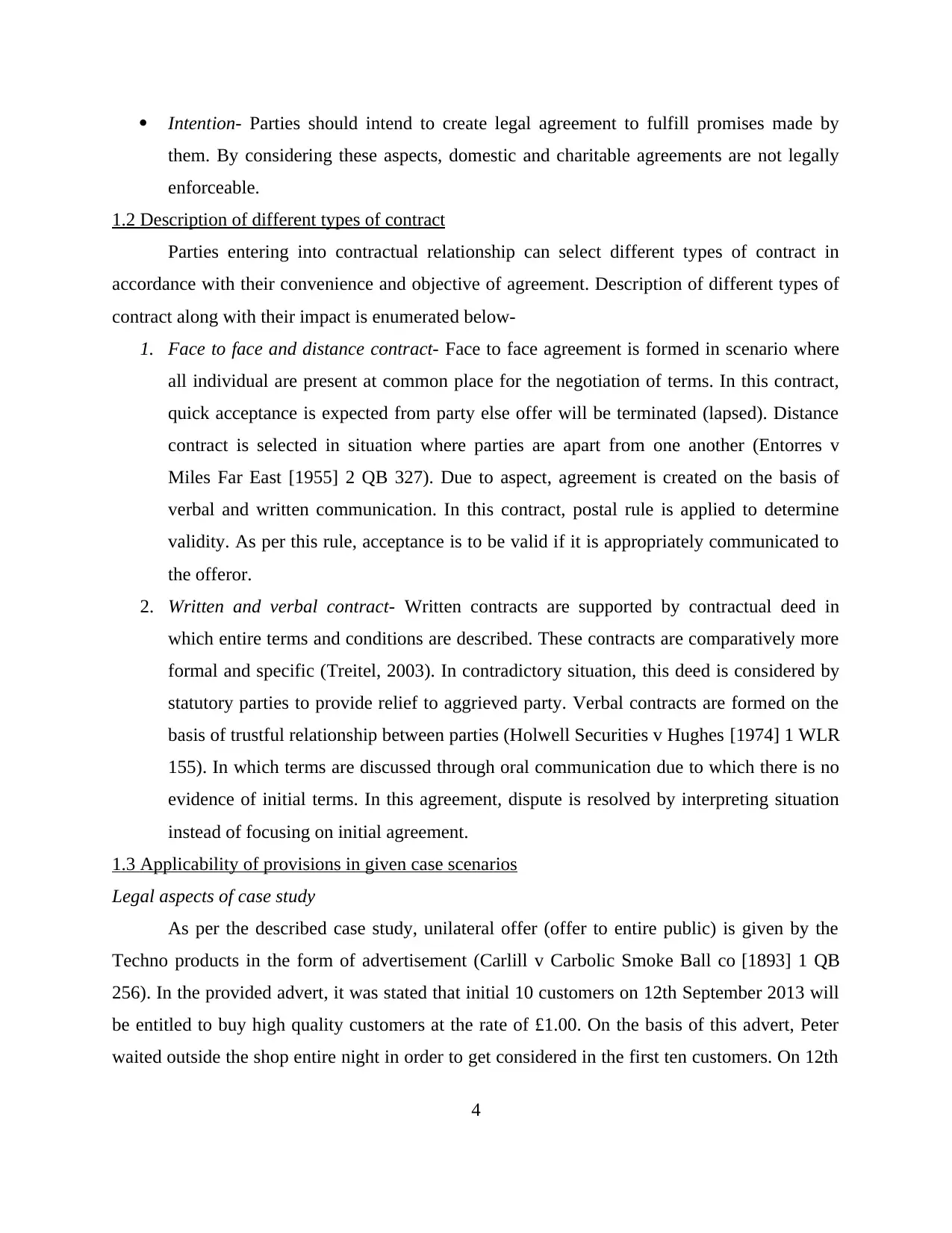
Intention- Parties should intend to create legal agreement to fulfill promises made by
them. By considering these aspects, domestic and charitable agreements are not legally
enforceable.
1.2 Description of different types of contract
Parties entering into contractual relationship can select different types of contract in
accordance with their convenience and objective of agreement. Description of different types of
contract along with their impact is enumerated below-
1. Face to face and distance contract- Face to face agreement is formed in scenario where
all individual are present at common place for the negotiation of terms. In this contract,
quick acceptance is expected from party else offer will be terminated (lapsed). Distance
contract is selected in situation where parties are apart from one another (Entorres v
Miles Far East [1955] 2 QB 327). Due to aspect, agreement is created on the basis of
verbal and written communication. In this contract, postal rule is applied to determine
validity. As per this rule, acceptance is to be valid if it is appropriately communicated to
the offeror.
2. Written and verbal contract- Written contracts are supported by contractual deed in
which entire terms and conditions are described. These contracts are comparatively more
formal and specific (Treitel, 2003). In contradictory situation, this deed is considered by
statutory parties to provide relief to aggrieved party. Verbal contracts are formed on the
basis of trustful relationship between parties (Holwell Securities v Hughes [1974] 1 WLR
155). In which terms are discussed through oral communication due to which there is no
evidence of initial terms. In this agreement, dispute is resolved by interpreting situation
instead of focusing on initial agreement.
1.3 Applicability of provisions in given case scenarios
Legal aspects of case study
As per the described case study, unilateral offer (offer to entire public) is given by the
Techno products in the form of advertisement (Carlill v Carbolic Smoke Ball co [1893] 1 QB
256). In the provided advert, it was stated that initial 10 customers on 12th September 2013 will
be entitled to buy high quality customers at the rate of £1.00. On the basis of this advert, Peter
waited outside the shop entire night in order to get considered in the first ten customers. On 12th
4
them. By considering these aspects, domestic and charitable agreements are not legally
enforceable.
1.2 Description of different types of contract
Parties entering into contractual relationship can select different types of contract in
accordance with their convenience and objective of agreement. Description of different types of
contract along with their impact is enumerated below-
1. Face to face and distance contract- Face to face agreement is formed in scenario where
all individual are present at common place for the negotiation of terms. In this contract,
quick acceptance is expected from party else offer will be terminated (lapsed). Distance
contract is selected in situation where parties are apart from one another (Entorres v
Miles Far East [1955] 2 QB 327). Due to aspect, agreement is created on the basis of
verbal and written communication. In this contract, postal rule is applied to determine
validity. As per this rule, acceptance is to be valid if it is appropriately communicated to
the offeror.
2. Written and verbal contract- Written contracts are supported by contractual deed in
which entire terms and conditions are described. These contracts are comparatively more
formal and specific (Treitel, 2003). In contradictory situation, this deed is considered by
statutory parties to provide relief to aggrieved party. Verbal contracts are formed on the
basis of trustful relationship between parties (Holwell Securities v Hughes [1974] 1 WLR
155). In which terms are discussed through oral communication due to which there is no
evidence of initial terms. In this agreement, dispute is resolved by interpreting situation
instead of focusing on initial agreement.
1.3 Applicability of provisions in given case scenarios
Legal aspects of case study
As per the described case study, unilateral offer (offer to entire public) is given by the
Techno products in the form of advertisement (Carlill v Carbolic Smoke Ball co [1893] 1 QB
256). In the provided advert, it was stated that initial 10 customers on 12th September 2013 will
be entitled to buy high quality customers at the rate of £1.00. On the basis of this advert, Peter
waited outside the shop entire night in order to get considered in the first ten customers. On 12th
4
Paraphrase This Document
Need a fresh take? Get an instant paraphrase of this document with our AI Paraphraser
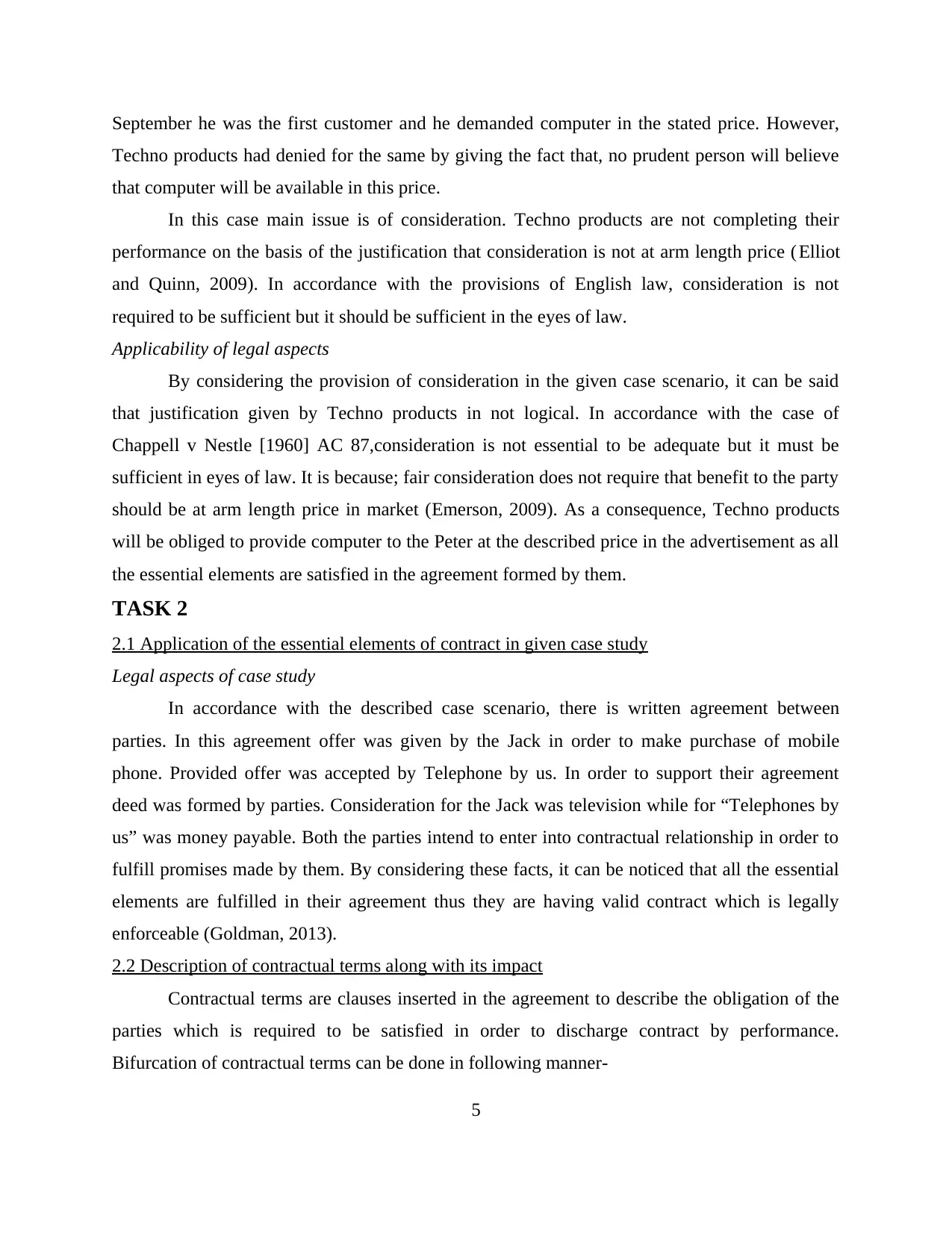
September he was the first customer and he demanded computer in the stated price. However,
Techno products had denied for the same by giving the fact that, no prudent person will believe
that computer will be available in this price.
In this case main issue is of consideration. Techno products are not completing their
performance on the basis of the justification that consideration is not at arm length price ( Elliot
and Quinn, 2009). In accordance with the provisions of English law, consideration is not
required to be sufficient but it should be sufficient in the eyes of law.
Applicability of legal aspects
By considering the provision of consideration in the given case scenario, it can be said
that justification given by Techno products in not logical. In accordance with the case of
Chappell v Nestle [1960] AC 87,consideration is not essential to be adequate but it must be
sufficient in eyes of law. It is because; fair consideration does not require that benefit to the party
should be at arm length price in market (Emerson, 2009). As a consequence, Techno products
will be obliged to provide computer to the Peter at the described price in the advertisement as all
the essential elements are satisfied in the agreement formed by them.
TASK 2
2.1 Application of the essential elements of contract in given case study
Legal aspects of case study
In accordance with the described case scenario, there is written agreement between
parties. In this agreement offer was given by the Jack in order to make purchase of mobile
phone. Provided offer was accepted by Telephone by us. In order to support their agreement
deed was formed by parties. Consideration for the Jack was television while for “Telephones by
us” was money payable. Both the parties intend to enter into contractual relationship in order to
fulfill promises made by them. By considering these facts, it can be noticed that all the essential
elements are fulfilled in their agreement thus they are having valid contract which is legally
enforceable (Goldman, 2013).
2.2 Description of contractual terms along with its impact
Contractual terms are clauses inserted in the agreement to describe the obligation of the
parties which is required to be satisfied in order to discharge contract by performance.
Bifurcation of contractual terms can be done in following manner-
5
Techno products had denied for the same by giving the fact that, no prudent person will believe
that computer will be available in this price.
In this case main issue is of consideration. Techno products are not completing their
performance on the basis of the justification that consideration is not at arm length price ( Elliot
and Quinn, 2009). In accordance with the provisions of English law, consideration is not
required to be sufficient but it should be sufficient in the eyes of law.
Applicability of legal aspects
By considering the provision of consideration in the given case scenario, it can be said
that justification given by Techno products in not logical. In accordance with the case of
Chappell v Nestle [1960] AC 87,consideration is not essential to be adequate but it must be
sufficient in eyes of law. It is because; fair consideration does not require that benefit to the party
should be at arm length price in market (Emerson, 2009). As a consequence, Techno products
will be obliged to provide computer to the Peter at the described price in the advertisement as all
the essential elements are satisfied in the agreement formed by them.
TASK 2
2.1 Application of the essential elements of contract in given case study
Legal aspects of case study
In accordance with the described case scenario, there is written agreement between
parties. In this agreement offer was given by the Jack in order to make purchase of mobile
phone. Provided offer was accepted by Telephone by us. In order to support their agreement
deed was formed by parties. Consideration for the Jack was television while for “Telephones by
us” was money payable. Both the parties intend to enter into contractual relationship in order to
fulfill promises made by them. By considering these facts, it can be noticed that all the essential
elements are fulfilled in their agreement thus they are having valid contract which is legally
enforceable (Goldman, 2013).
2.2 Description of contractual terms along with its impact
Contractual terms are clauses inserted in the agreement to describe the obligation of the
parties which is required to be satisfied in order to discharge contract by performance.
Bifurcation of contractual terms can be done in following manner-
5
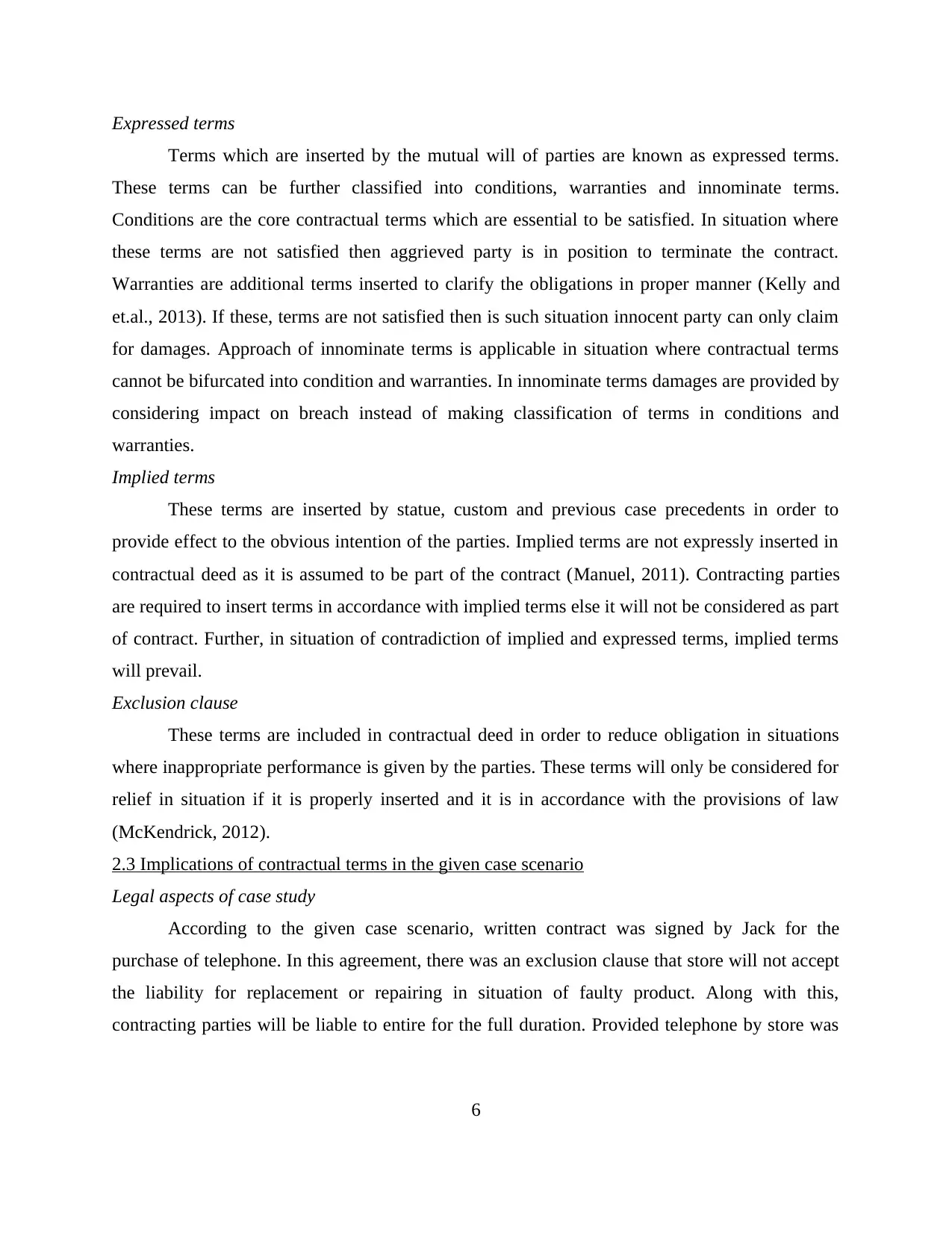
Expressed terms
Terms which are inserted by the mutual will of parties are known as expressed terms.
These terms can be further classified into conditions, warranties and innominate terms.
Conditions are the core contractual terms which are essential to be satisfied. In situation where
these terms are not satisfied then aggrieved party is in position to terminate the contract.
Warranties are additional terms inserted to clarify the obligations in proper manner (Kelly and
et.al., 2013). If these, terms are not satisfied then is such situation innocent party can only claim
for damages. Approach of innominate terms is applicable in situation where contractual terms
cannot be bifurcated into condition and warranties. In innominate terms damages are provided by
considering impact on breach instead of making classification of terms in conditions and
warranties.
Implied terms
These terms are inserted by statue, custom and previous case precedents in order to
provide effect to the obvious intention of the parties. Implied terms are not expressly inserted in
contractual deed as it is assumed to be part of the contract (Manuel, 2011). Contracting parties
are required to insert terms in accordance with implied terms else it will not be considered as part
of contract. Further, in situation of contradiction of implied and expressed terms, implied terms
will prevail.
Exclusion clause
These terms are included in contractual deed in order to reduce obligation in situations
where inappropriate performance is given by the parties. These terms will only be considered for
relief in situation if it is properly inserted and it is in accordance with the provisions of law
(McKendrick, 2012).
2.3 Implications of contractual terms in the given case scenario
Legal aspects of case study
According to the given case scenario, written contract was signed by Jack for the
purchase of telephone. In this agreement, there was an exclusion clause that store will not accept
the liability for replacement or repairing in situation of faulty product. Along with this,
contracting parties will be liable to entire for the full duration. Provided telephone by store was
6
Terms which are inserted by the mutual will of parties are known as expressed terms.
These terms can be further classified into conditions, warranties and innominate terms.
Conditions are the core contractual terms which are essential to be satisfied. In situation where
these terms are not satisfied then aggrieved party is in position to terminate the contract.
Warranties are additional terms inserted to clarify the obligations in proper manner (Kelly and
et.al., 2013). If these, terms are not satisfied then is such situation innocent party can only claim
for damages. Approach of innominate terms is applicable in situation where contractual terms
cannot be bifurcated into condition and warranties. In innominate terms damages are provided by
considering impact on breach instead of making classification of terms in conditions and
warranties.
Implied terms
These terms are inserted by statue, custom and previous case precedents in order to
provide effect to the obvious intention of the parties. Implied terms are not expressly inserted in
contractual deed as it is assumed to be part of the contract (Manuel, 2011). Contracting parties
are required to insert terms in accordance with implied terms else it will not be considered as part
of contract. Further, in situation of contradiction of implied and expressed terms, implied terms
will prevail.
Exclusion clause
These terms are included in contractual deed in order to reduce obligation in situations
where inappropriate performance is given by the parties. These terms will only be considered for
relief in situation if it is properly inserted and it is in accordance with the provisions of law
(McKendrick, 2012).
2.3 Implications of contractual terms in the given case scenario
Legal aspects of case study
According to the given case scenario, written contract was signed by Jack for the
purchase of telephone. In this agreement, there was an exclusion clause that store will not accept
the liability for replacement or repairing in situation of faulty product. Along with this,
contracting parties will be liable to entire for the full duration. Provided telephone by store was
6
⊘ This is a preview!⊘
Do you want full access?
Subscribe today to unlock all pages.

Trusted by 1+ million students worldwide
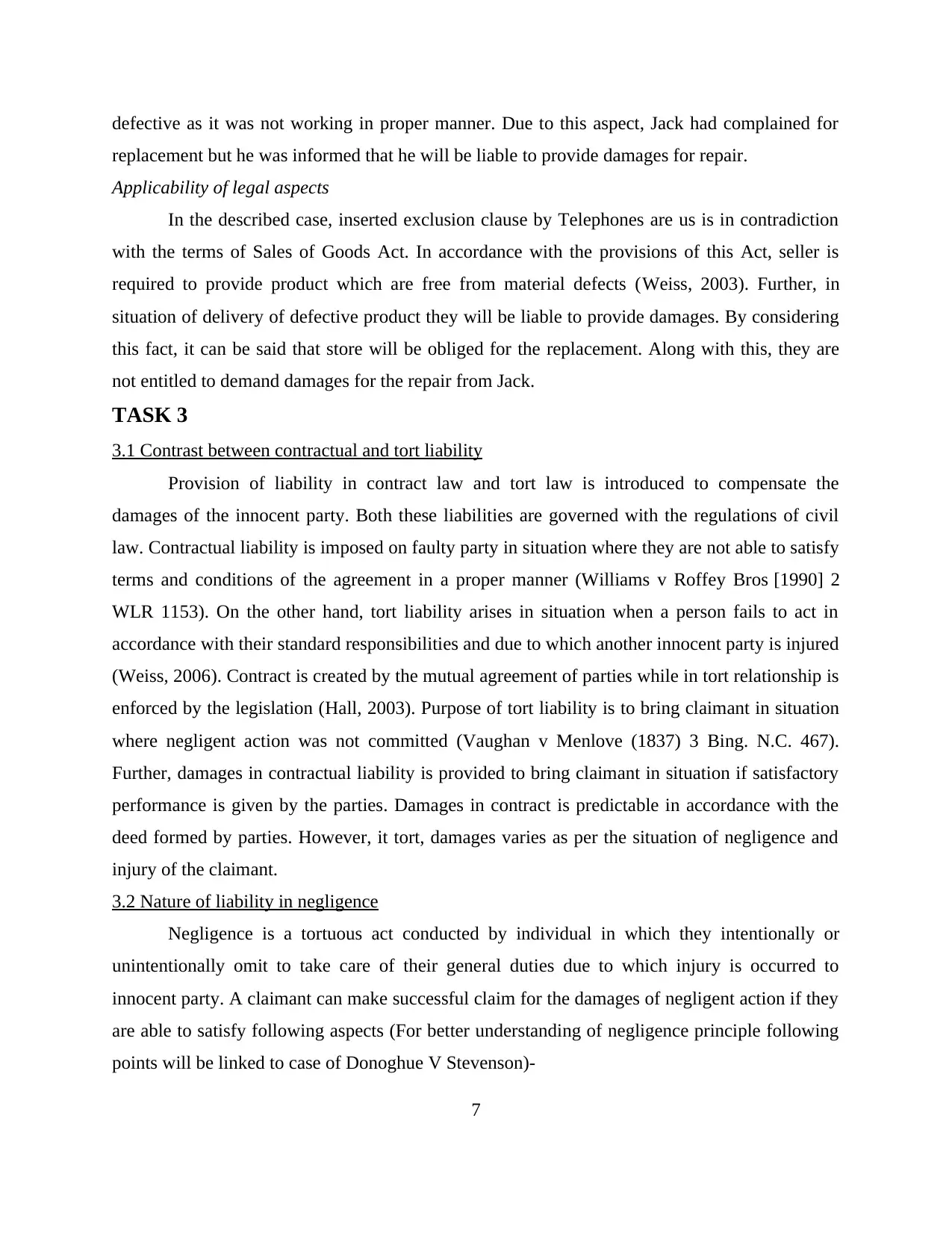
defective as it was not working in proper manner. Due to this aspect, Jack had complained for
replacement but he was informed that he will be liable to provide damages for repair.
Applicability of legal aspects
In the described case, inserted exclusion clause by Telephones are us is in contradiction
with the terms of Sales of Goods Act. In accordance with the provisions of this Act, seller is
required to provide product which are free from material defects (Weiss, 2003). Further, in
situation of delivery of defective product they will be liable to provide damages. By considering
this fact, it can be said that store will be obliged for the replacement. Along with this, they are
not entitled to demand damages for the repair from Jack.
TASK 3
3.1 Contrast between contractual and tort liability
Provision of liability in contract law and tort law is introduced to compensate the
damages of the innocent party. Both these liabilities are governed with the regulations of civil
law. Contractual liability is imposed on faulty party in situation where they are not able to satisfy
terms and conditions of the agreement in a proper manner (Williams v Roffey Bros [1990] 2
WLR 1153). On the other hand, tort liability arises in situation when a person fails to act in
accordance with their standard responsibilities and due to which another innocent party is injured
(Weiss, 2006). Contract is created by the mutual agreement of parties while in tort relationship is
enforced by the legislation (Hall, 2003). Purpose of tort liability is to bring claimant in situation
where negligent action was not committed (Vaughan v Menlove (1837) 3 Bing. N.C. 467).
Further, damages in contractual liability is provided to bring claimant in situation if satisfactory
performance is given by the parties. Damages in contract is predictable in accordance with the
deed formed by parties. However, it tort, damages varies as per the situation of negligence and
injury of the claimant.
3.2 Nature of liability in negligence
Negligence is a tortuous act conducted by individual in which they intentionally or
unintentionally omit to take care of their general duties due to which injury is occurred to
innocent party. A claimant can make successful claim for the damages of negligent action if they
are able to satisfy following aspects (For better understanding of negligence principle following
points will be linked to case of Donoghue V Stevenson)-
7
replacement but he was informed that he will be liable to provide damages for repair.
Applicability of legal aspects
In the described case, inserted exclusion clause by Telephones are us is in contradiction
with the terms of Sales of Goods Act. In accordance with the provisions of this Act, seller is
required to provide product which are free from material defects (Weiss, 2003). Further, in
situation of delivery of defective product they will be liable to provide damages. By considering
this fact, it can be said that store will be obliged for the replacement. Along with this, they are
not entitled to demand damages for the repair from Jack.
TASK 3
3.1 Contrast between contractual and tort liability
Provision of liability in contract law and tort law is introduced to compensate the
damages of the innocent party. Both these liabilities are governed with the regulations of civil
law. Contractual liability is imposed on faulty party in situation where they are not able to satisfy
terms and conditions of the agreement in a proper manner (Williams v Roffey Bros [1990] 2
WLR 1153). On the other hand, tort liability arises in situation when a person fails to act in
accordance with their standard responsibilities and due to which another innocent party is injured
(Weiss, 2006). Contract is created by the mutual agreement of parties while in tort relationship is
enforced by the legislation (Hall, 2003). Purpose of tort liability is to bring claimant in situation
where negligent action was not committed (Vaughan v Menlove (1837) 3 Bing. N.C. 467).
Further, damages in contractual liability is provided to bring claimant in situation if satisfactory
performance is given by the parties. Damages in contract is predictable in accordance with the
deed formed by parties. However, it tort, damages varies as per the situation of negligence and
injury of the claimant.
3.2 Nature of liability in negligence
Negligence is a tortuous act conducted by individual in which they intentionally or
unintentionally omit to take care of their general duties due to which injury is occurred to
innocent party. A claimant can make successful claim for the damages of negligent action if they
are able to satisfy following aspects (For better understanding of negligence principle following
points will be linked to case of Donoghue V Stevenson)-
7
Paraphrase This Document
Need a fresh take? Get an instant paraphrase of this document with our AI Paraphraser
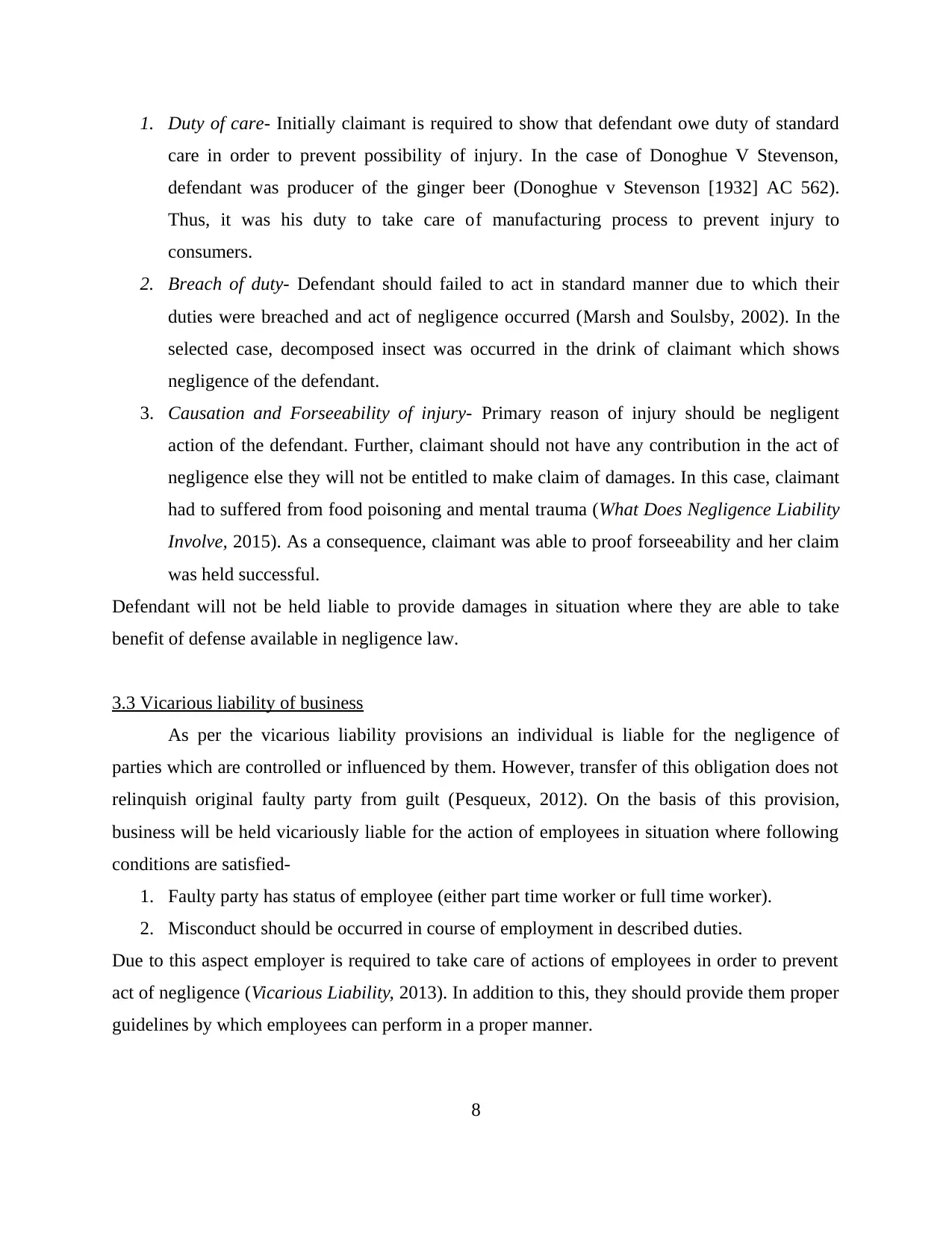
1. Duty of care- Initially claimant is required to show that defendant owe duty of standard
care in order to prevent possibility of injury. In the case of Donoghue V Stevenson,
defendant was producer of the ginger beer (Donoghue v Stevenson [1932] AC 562).
Thus, it was his duty to take care of manufacturing process to prevent injury to
consumers.
2. Breach of duty- Defendant should failed to act in standard manner due to which their
duties were breached and act of negligence occurred (Marsh and Soulsby, 2002). In the
selected case, decomposed insect was occurred in the drink of claimant which shows
negligence of the defendant.
3. Causation and Forseeability of injury- Primary reason of injury should be negligent
action of the defendant. Further, claimant should not have any contribution in the act of
negligence else they will not be entitled to make claim of damages. In this case, claimant
had to suffered from food poisoning and mental trauma (What Does Negligence Liability
Involve, 2015). As a consequence, claimant was able to proof forseeability and her claim
was held successful.
Defendant will not be held liable to provide damages in situation where they are able to take
benefit of defense available in negligence law.
3.3 Vicarious liability of business
As per the vicarious liability provisions an individual is liable for the negligence of
parties which are controlled or influenced by them. However, transfer of this obligation does not
relinquish original faulty party from guilt (Pesqueux, 2012). On the basis of this provision,
business will be held vicariously liable for the action of employees in situation where following
conditions are satisfied-
1. Faulty party has status of employee (either part time worker or full time worker).
2. Misconduct should be occurred in course of employment in described duties.
Due to this aspect employer is required to take care of actions of employees in order to prevent
act of negligence (Vicarious Liability, 2013). In addition to this, they should provide them proper
guidelines by which employees can perform in a proper manner.
8
care in order to prevent possibility of injury. In the case of Donoghue V Stevenson,
defendant was producer of the ginger beer (Donoghue v Stevenson [1932] AC 562).
Thus, it was his duty to take care of manufacturing process to prevent injury to
consumers.
2. Breach of duty- Defendant should failed to act in standard manner due to which their
duties were breached and act of negligence occurred (Marsh and Soulsby, 2002). In the
selected case, decomposed insect was occurred in the drink of claimant which shows
negligence of the defendant.
3. Causation and Forseeability of injury- Primary reason of injury should be negligent
action of the defendant. Further, claimant should not have any contribution in the act of
negligence else they will not be entitled to make claim of damages. In this case, claimant
had to suffered from food poisoning and mental trauma (What Does Negligence Liability
Involve, 2015). As a consequence, claimant was able to proof forseeability and her claim
was held successful.
Defendant will not be held liable to provide damages in situation where they are able to take
benefit of defense available in negligence law.
3.3 Vicarious liability of business
As per the vicarious liability provisions an individual is liable for the negligence of
parties which are controlled or influenced by them. However, transfer of this obligation does not
relinquish original faulty party from guilt (Pesqueux, 2012). On the basis of this provision,
business will be held vicariously liable for the action of employees in situation where following
conditions are satisfied-
1. Faulty party has status of employee (either part time worker or full time worker).
2. Misconduct should be occurred in course of employment in described duties.
Due to this aspect employer is required to take care of actions of employees in order to prevent
act of negligence (Vicarious Liability, 2013). In addition to this, they should provide them proper
guidelines by which employees can perform in a proper manner.
8
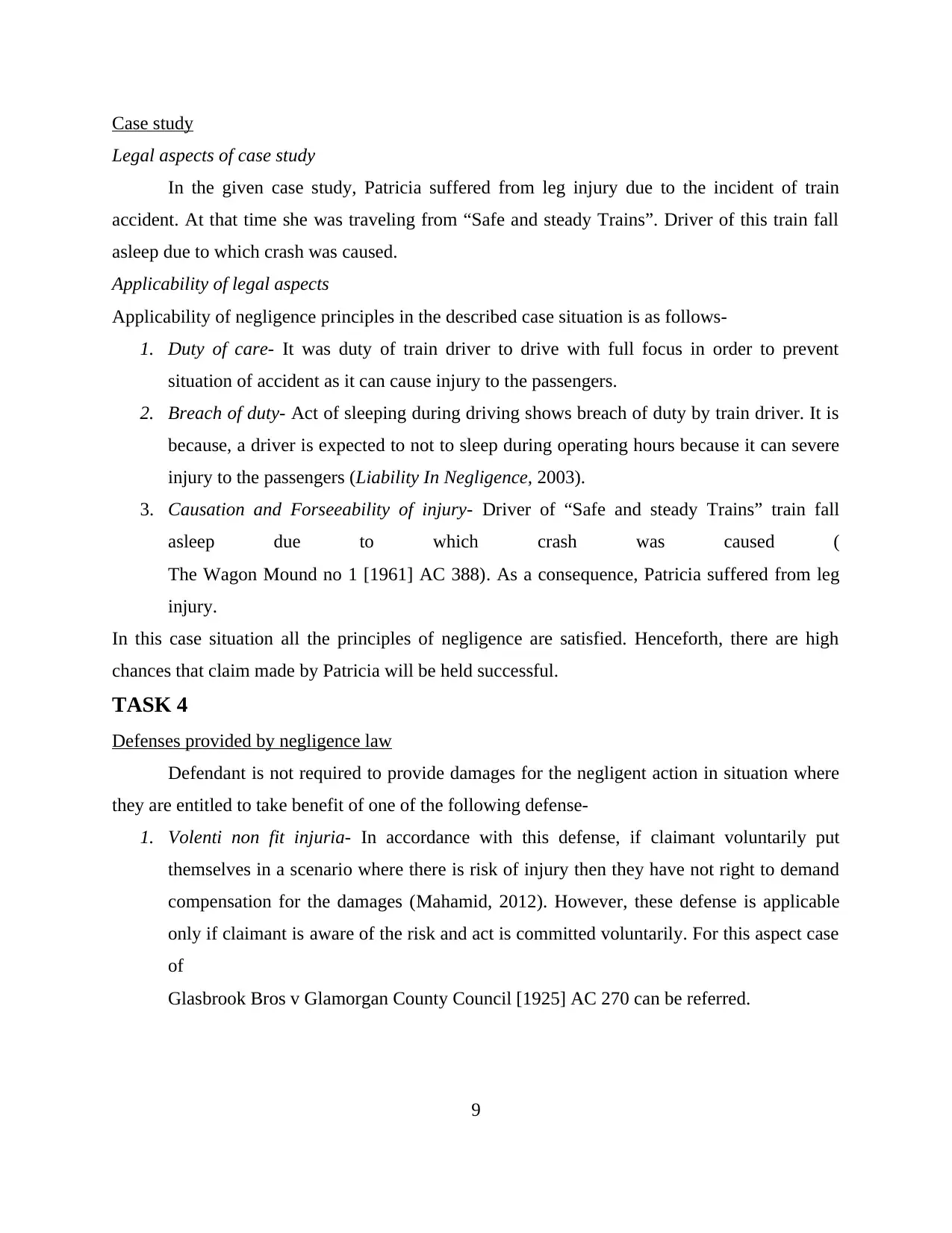
Case study
Legal aspects of case study
In the given case study, Patricia suffered from leg injury due to the incident of train
accident. At that time she was traveling from “Safe and steady Trains”. Driver of this train fall
asleep due to which crash was caused.
Applicability of legal aspects
Applicability of negligence principles in the described case situation is as follows-
1. Duty of care- It was duty of train driver to drive with full focus in order to prevent
situation of accident as it can cause injury to the passengers.
2. Breach of duty- Act of sleeping during driving shows breach of duty by train driver. It is
because, a driver is expected to not to sleep during operating hours because it can severe
injury to the passengers (Liability In Negligence, 2003).
3. Causation and Forseeability of injury- Driver of “Safe and steady Trains” train fall
asleep due to which crash was caused (
The Wagon Mound no 1 [1961] AC 388). As a consequence, Patricia suffered from leg
injury.
In this case situation all the principles of negligence are satisfied. Henceforth, there are high
chances that claim made by Patricia will be held successful.
TASK 4
Defenses provided by negligence law
Defendant is not required to provide damages for the negligent action in situation where
they are entitled to take benefit of one of the following defense-
1. Volenti non fit injuria- In accordance with this defense, if claimant voluntarily put
themselves in a scenario where there is risk of injury then they have not right to demand
compensation for the damages (Mahamid, 2012). However, these defense is applicable
only if claimant is aware of the risk and act is committed voluntarily. For this aspect case
of
Glasbrook Bros v Glamorgan County Council [1925] AC 270 can be referred.
9
Legal aspects of case study
In the given case study, Patricia suffered from leg injury due to the incident of train
accident. At that time she was traveling from “Safe and steady Trains”. Driver of this train fall
asleep due to which crash was caused.
Applicability of legal aspects
Applicability of negligence principles in the described case situation is as follows-
1. Duty of care- It was duty of train driver to drive with full focus in order to prevent
situation of accident as it can cause injury to the passengers.
2. Breach of duty- Act of sleeping during driving shows breach of duty by train driver. It is
because, a driver is expected to not to sleep during operating hours because it can severe
injury to the passengers (Liability In Negligence, 2003).
3. Causation and Forseeability of injury- Driver of “Safe and steady Trains” train fall
asleep due to which crash was caused (
The Wagon Mound no 1 [1961] AC 388). As a consequence, Patricia suffered from leg
injury.
In this case situation all the principles of negligence are satisfied. Henceforth, there are high
chances that claim made by Patricia will be held successful.
TASK 4
Defenses provided by negligence law
Defendant is not required to provide damages for the negligent action in situation where
they are entitled to take benefit of one of the following defense-
1. Volenti non fit injuria- In accordance with this defense, if claimant voluntarily put
themselves in a scenario where there is risk of injury then they have not right to demand
compensation for the damages (Mahamid, 2012). However, these defense is applicable
only if claimant is aware of the risk and act is committed voluntarily. For this aspect case
of
Glasbrook Bros v Glamorgan County Council [1925] AC 270 can be referred.
9
⊘ This is a preview!⊘
Do you want full access?
Subscribe today to unlock all pages.

Trusted by 1+ million students worldwide
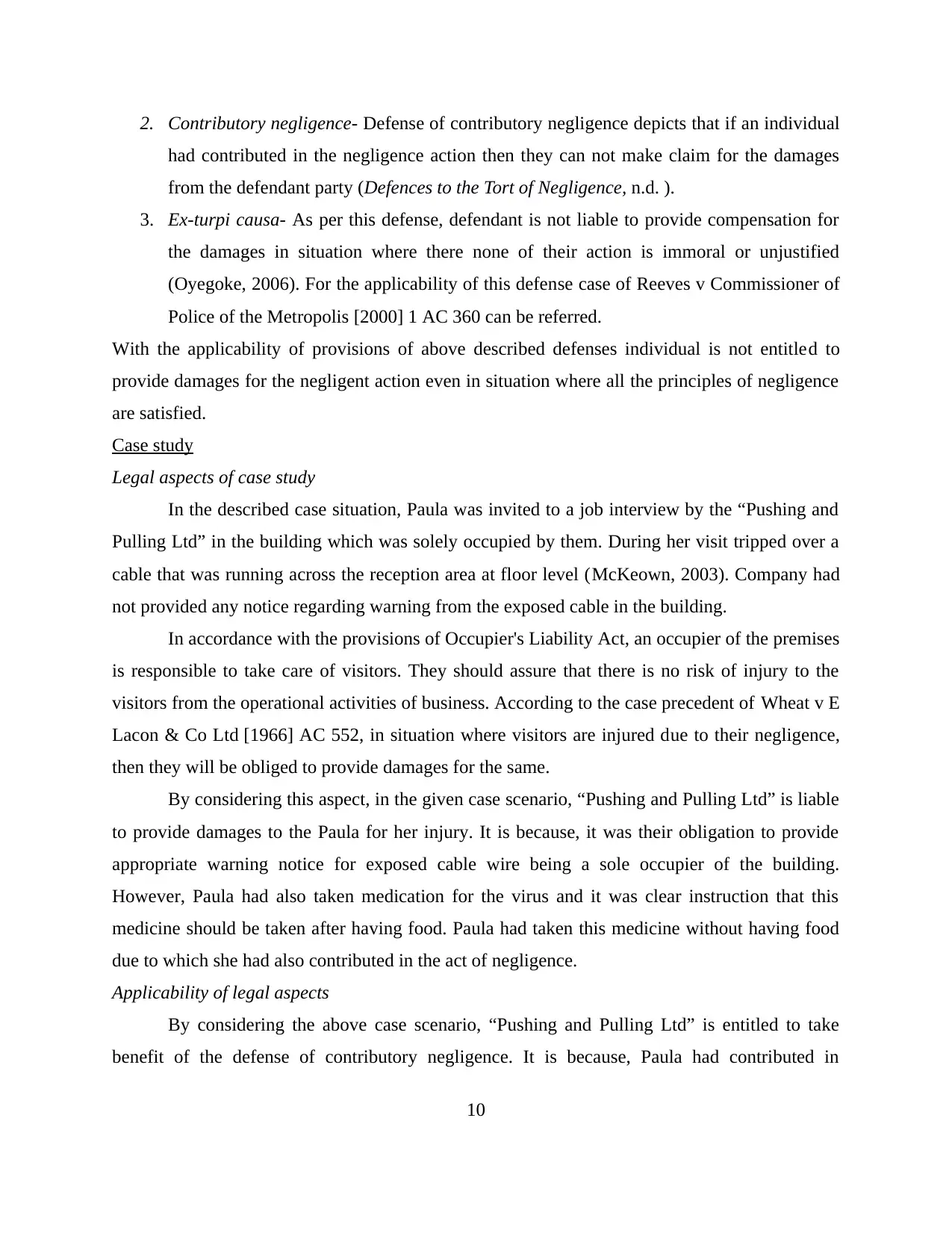
2. Contributory negligence- Defense of contributory negligence depicts that if an individual
had contributed in the negligence action then they can not make claim for the damages
from the defendant party (Defences to the Tort of Negligence, n.d. ).
3. Ex-turpi causa- As per this defense, defendant is not liable to provide compensation for
the damages in situation where there none of their action is immoral or unjustified
(Oyegoke, 2006). For the applicability of this defense case of Reeves v Commissioner of
Police of the Metropolis [2000] 1 AC 360 can be referred.
With the applicability of provisions of above described defenses individual is not entitled to
provide damages for the negligent action even in situation where all the principles of negligence
are satisfied.
Case study
Legal aspects of case study
In the described case situation, Paula was invited to a job interview by the “Pushing and
Pulling Ltd” in the building which was solely occupied by them. During her visit tripped over a
cable that was running across the reception area at floor level (McKeown, 2003). Company had
not provided any notice regarding warning from the exposed cable in the building.
In accordance with the provisions of Occupier's Liability Act, an occupier of the premises
is responsible to take care of visitors. They should assure that there is no risk of injury to the
visitors from the operational activities of business. According to the case precedent of Wheat v E
Lacon & Co Ltd [1966] AC 552, in situation where visitors are injured due to their negligence,
then they will be obliged to provide damages for the same.
By considering this aspect, in the given case scenario, “Pushing and Pulling Ltd” is liable
to provide damages to the Paula for her injury. It is because, it was their obligation to provide
appropriate warning notice for exposed cable wire being a sole occupier of the building.
However, Paula had also taken medication for the virus and it was clear instruction that this
medicine should be taken after having food. Paula had taken this medicine without having food
due to which she had also contributed in the act of negligence.
Applicability of legal aspects
By considering the above case scenario, “Pushing and Pulling Ltd” is entitled to take
benefit of the defense of contributory negligence. It is because, Paula had contributed in
10
had contributed in the negligence action then they can not make claim for the damages
from the defendant party (Defences to the Tort of Negligence, n.d. ).
3. Ex-turpi causa- As per this defense, defendant is not liable to provide compensation for
the damages in situation where there none of their action is immoral or unjustified
(Oyegoke, 2006). For the applicability of this defense case of Reeves v Commissioner of
Police of the Metropolis [2000] 1 AC 360 can be referred.
With the applicability of provisions of above described defenses individual is not entitled to
provide damages for the negligent action even in situation where all the principles of negligence
are satisfied.
Case study
Legal aspects of case study
In the described case situation, Paula was invited to a job interview by the “Pushing and
Pulling Ltd” in the building which was solely occupied by them. During her visit tripped over a
cable that was running across the reception area at floor level (McKeown, 2003). Company had
not provided any notice regarding warning from the exposed cable in the building.
In accordance with the provisions of Occupier's Liability Act, an occupier of the premises
is responsible to take care of visitors. They should assure that there is no risk of injury to the
visitors from the operational activities of business. According to the case precedent of Wheat v E
Lacon & Co Ltd [1966] AC 552, in situation where visitors are injured due to their negligence,
then they will be obliged to provide damages for the same.
By considering this aspect, in the given case scenario, “Pushing and Pulling Ltd” is liable
to provide damages to the Paula for her injury. It is because, it was their obligation to provide
appropriate warning notice for exposed cable wire being a sole occupier of the building.
However, Paula had also taken medication for the virus and it was clear instruction that this
medicine should be taken after having food. Paula had taken this medicine without having food
due to which she had also contributed in the act of negligence.
Applicability of legal aspects
By considering the above case scenario, “Pushing and Pulling Ltd” is entitled to take
benefit of the defense of contributory negligence. It is because, Paula had contributed in
10
Paraphrase This Document
Need a fresh take? Get an instant paraphrase of this document with our AI Paraphraser
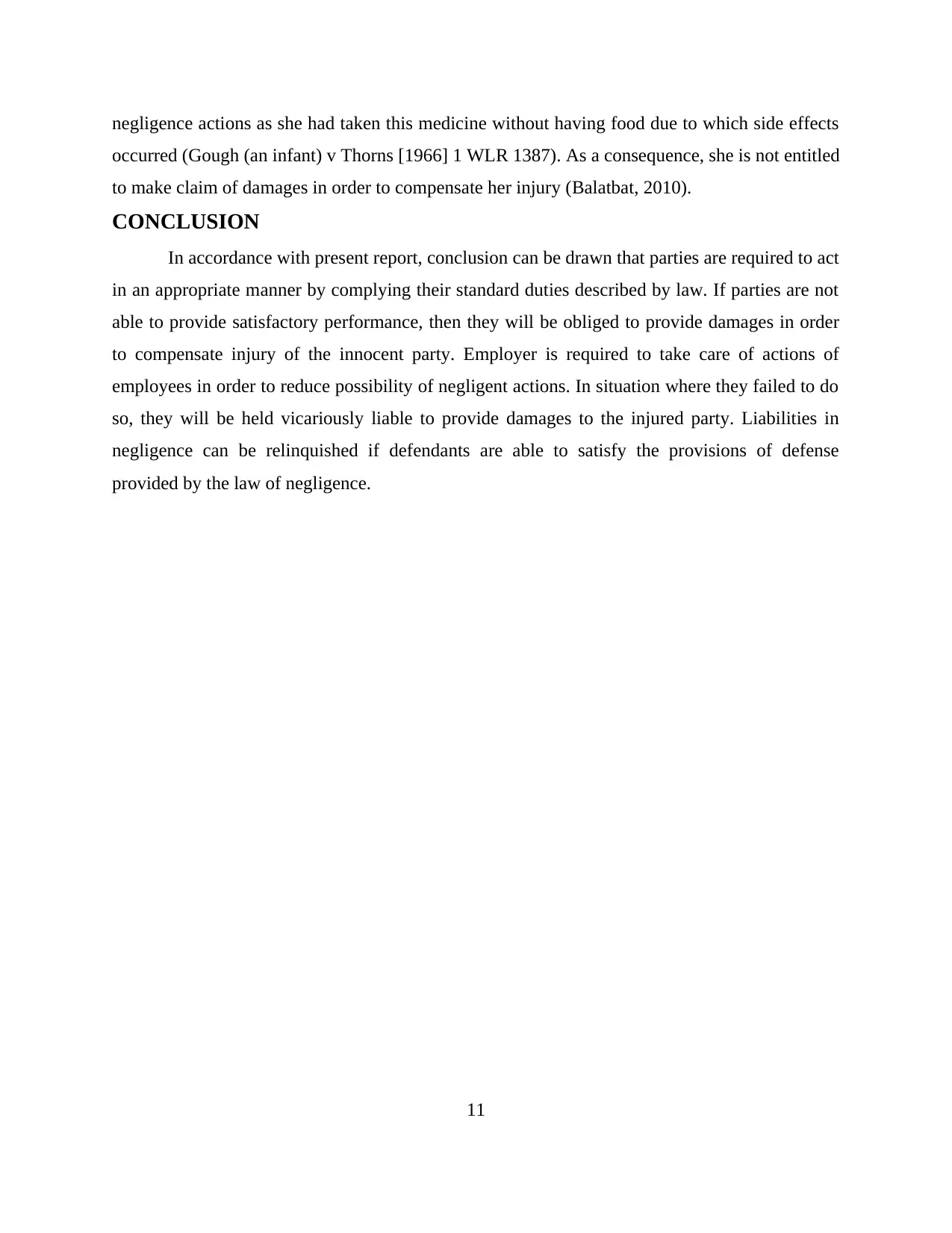
negligence actions as she had taken this medicine without having food due to which side effects
occurred (Gough (an infant) v Thorns [1966] 1 WLR 1387). As a consequence, she is not entitled
to make claim of damages in order to compensate her injury (Balatbat, 2010).
CONCLUSION
In accordance with present report, conclusion can be drawn that parties are required to act
in an appropriate manner by complying their standard duties described by law. If parties are not
able to provide satisfactory performance, then they will be obliged to provide damages in order
to compensate injury of the innocent party. Employer is required to take care of actions of
employees in order to reduce possibility of negligent actions. In situation where they failed to do
so, they will be held vicariously liable to provide damages to the injured party. Liabilities in
negligence can be relinquished if defendants are able to satisfy the provisions of defense
provided by the law of negligence.
11
occurred (Gough (an infant) v Thorns [1966] 1 WLR 1387). As a consequence, she is not entitled
to make claim of damages in order to compensate her injury (Balatbat, 2010).
CONCLUSION
In accordance with present report, conclusion can be drawn that parties are required to act
in an appropriate manner by complying their standard duties described by law. If parties are not
able to provide satisfactory performance, then they will be obliged to provide damages in order
to compensate injury of the innocent party. Employer is required to take care of actions of
employees in order to reduce possibility of negligent actions. In situation where they failed to do
so, they will be held vicariously liable to provide damages to the injured party. Liabilities in
negligence can be relinquished if defendants are able to satisfy the provisions of defense
provided by the law of negligence.
11
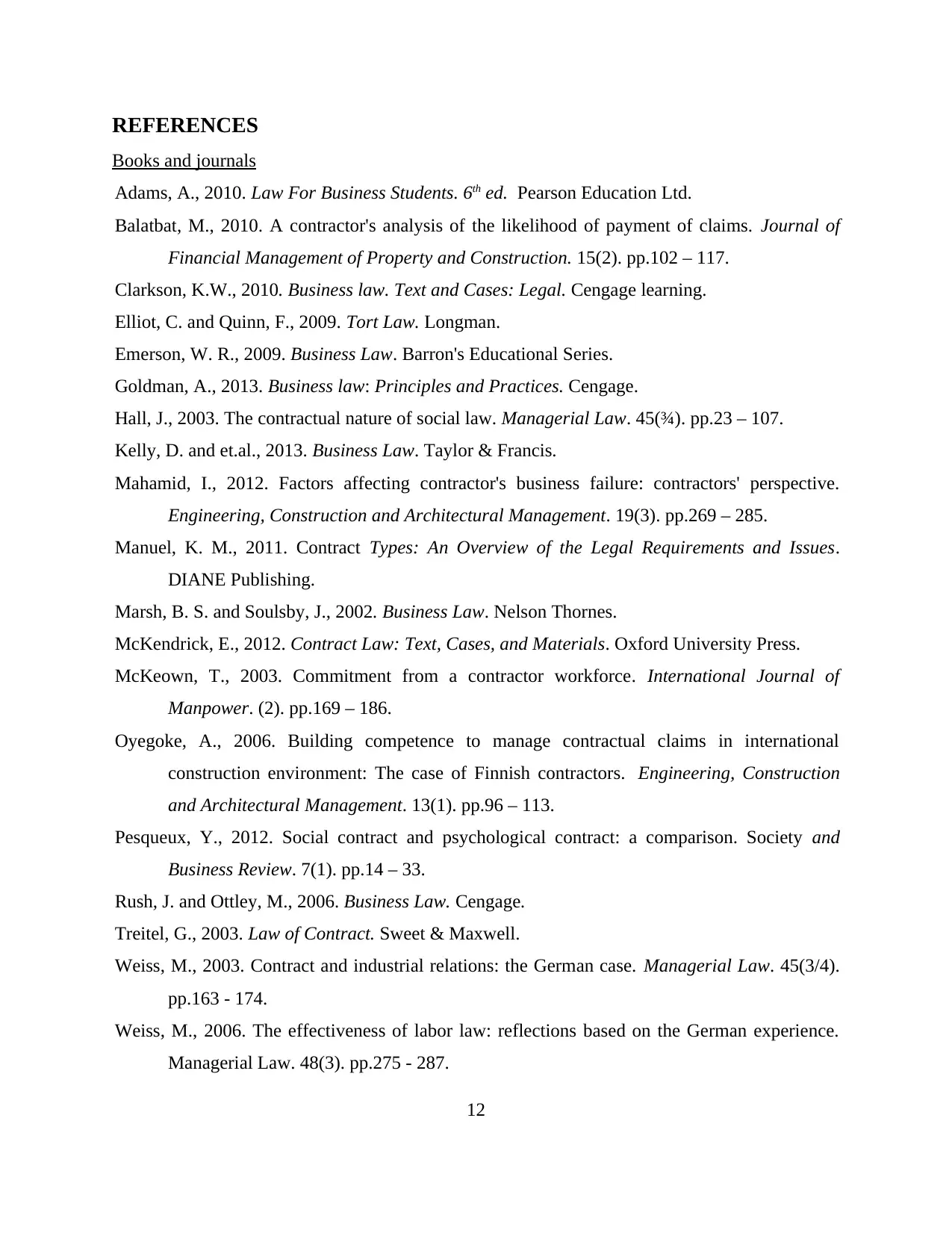
REFERENCES
Books and journals
Adams, A., 2010. Law For Business Students. 6th ed. Pearson Education Ltd.
Balatbat, M., 2010. A contractor's analysis of the likelihood of payment of claims. Journal of
Financial Management of Property and Construction. 15(2). pp.102 – 117.
Clarkson, K.W., 2010. Business law. Text and Cases: Legal. Cengage learning.
Elliot, C. and Quinn, F., 2009. Tort Law. Longman.
Emerson, W. R., 2009. Business Law. Barron's Educational Series.
Goldman, A., 2013. Business law: Principles and Practices. Cengage.
Hall, J., 2003. The contractual nature of social law. Managerial Law. 45(¾). pp.23 – 107.
Kelly, D. and et.al., 2013. Business Law. Taylor & Francis.
Mahamid, I., 2012. Factors affecting contractor's business failure: contractors' perspective.
Engineering, Construction and Architectural Management. 19(3). pp.269 – 285.
Manuel, K. M., 2011. Contract Types: An Overview of the Legal Requirements and Issues.
DIANE Publishing.
Marsh, B. S. and Soulsby, J., 2002. Business Law. Nelson Thornes.
McKendrick, E., 2012. Contract Law: Text, Cases, and Materials. Oxford University Press.
McKeown, T., 2003. Commitment from a contractor workforce. International Journal of
Manpower. (2). pp.169 – 186.
Oyegoke, A., 2006. Building competence to manage contractual claims in international
construction environment: The case of Finnish contractors. Engineering, Construction
and Architectural Management. 13(1). pp.96 – 113.
Pesqueux, Y., 2012. Social contract and psychological contract: a comparison. Society and
Business Review. 7(1). pp.14 – 33.
Rush, J. and Ottley, M., 2006. Business Law. Cengage.
Treitel, G., 2003. Law of Contract. Sweet & Maxwell.
Weiss, M., 2003. Contract and industrial relations: the German case. Managerial Law. 45(3/4).
pp.163 - 174.
Weiss, M., 2006. The effectiveness of labor law: reflections based on the German experience.
Managerial Law. 48(3). pp.275 - 287.
12
Books and journals
Adams, A., 2010. Law For Business Students. 6th ed. Pearson Education Ltd.
Balatbat, M., 2010. A contractor's analysis of the likelihood of payment of claims. Journal of
Financial Management of Property and Construction. 15(2). pp.102 – 117.
Clarkson, K.W., 2010. Business law. Text and Cases: Legal. Cengage learning.
Elliot, C. and Quinn, F., 2009. Tort Law. Longman.
Emerson, W. R., 2009. Business Law. Barron's Educational Series.
Goldman, A., 2013. Business law: Principles and Practices. Cengage.
Hall, J., 2003. The contractual nature of social law. Managerial Law. 45(¾). pp.23 – 107.
Kelly, D. and et.al., 2013. Business Law. Taylor & Francis.
Mahamid, I., 2012. Factors affecting contractor's business failure: contractors' perspective.
Engineering, Construction and Architectural Management. 19(3). pp.269 – 285.
Manuel, K. M., 2011. Contract Types: An Overview of the Legal Requirements and Issues.
DIANE Publishing.
Marsh, B. S. and Soulsby, J., 2002. Business Law. Nelson Thornes.
McKendrick, E., 2012. Contract Law: Text, Cases, and Materials. Oxford University Press.
McKeown, T., 2003. Commitment from a contractor workforce. International Journal of
Manpower. (2). pp.169 – 186.
Oyegoke, A., 2006. Building competence to manage contractual claims in international
construction environment: The case of Finnish contractors. Engineering, Construction
and Architectural Management. 13(1). pp.96 – 113.
Pesqueux, Y., 2012. Social contract and psychological contract: a comparison. Society and
Business Review. 7(1). pp.14 – 33.
Rush, J. and Ottley, M., 2006. Business Law. Cengage.
Treitel, G., 2003. Law of Contract. Sweet & Maxwell.
Weiss, M., 2003. Contract and industrial relations: the German case. Managerial Law. 45(3/4).
pp.163 - 174.
Weiss, M., 2006. The effectiveness of labor law: reflections based on the German experience.
Managerial Law. 48(3). pp.275 - 287.
12
⊘ This is a preview!⊘
Do you want full access?
Subscribe today to unlock all pages.

Trusted by 1+ million students worldwide
1 out of 13
Related Documents
Your All-in-One AI-Powered Toolkit for Academic Success.
+13062052269
info@desklib.com
Available 24*7 on WhatsApp / Email
![[object Object]](/_next/static/media/star-bottom.7253800d.svg)
Unlock your academic potential
Copyright © 2020–2025 A2Z Services. All Rights Reserved. Developed and managed by ZUCOL.





